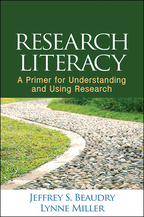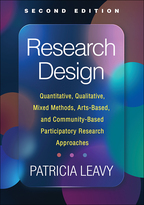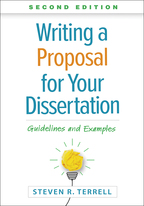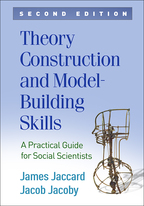Understanding and Interpreting Educational Research
Ronald C. Martella, J. Ron Nelson, Robert L. Morgan, and Nancy E. Marchand-Martella
1. Thinking Critically about Research
Objectives
Overview
How Important Is Critical Thinking?
What Are the Elements to Becoming a Critical Research Consumer?
What Are Science and the Scientific Method?
What Are the Purposes of Science?
What Is a Scientific Theory?
What Are the Types of Scientific Logic?
In What Ways Do We Gain Information?
What Are Constraint Levels in Educational and Psychological Research?
What Are the Differences between Basic and Applied Research?
What Is Replication Research?
Summary
Discussion Questions
II. CRITICAL ISSUES IN RESEARCH
2. Fundamental Issues for Interpreting Research
Objectives
What Is Variability?
What Is Internal Validity and Its Threats?
What Is External Validity and Its Threats?
What Are Statistical and Social Validities?
Summary
Discussion Questions
Interpretation Exercises
3. Reliability, Validity, and Interobserver Agreement
Objectives
Overview
What Are Reliability and Validity Issues in Quantitative Research?
How Do Researchers Assess the Reliability of Measurement Devices?
How Do Researchers Determine the Validity of Measurement Devices?
What Are Reliability and Validity Issues in Qualitative Research?
What Is Interobserver Agreement?
What Are the Methods of Establishing Interobserver Agreement?
What Are the Factors That Influence Interobserver Agreement?
What Are the Factors to Consider When Assessing Measurement Devices in the Context of a
Study?
Summary
Discussion Questions
Practice Exercises
III. QUANTITATIVE RESEARCH METHODS
4. Basic Statistical Concepts and Sampling Procedures
Objectives
Overview
What Are the Scales of Measurement?
What Is a Univariate Frequency Distribution?
How Can We Describe Data Sets?
What Role Do Hypotheses Play in Research?
What Are Parametric and Nonparametric Tests of Statistical Significance?
What Is Statistical Significance?
What Are Type I and Type II Errors and Power?
What Are the Types of Statistical Significance Testing Methods?
What Are the Different Sampling Methods?
What Are the Sampling Decisions Researchers Make?
What Is Sampling Error?
Summary
Discussion Questions
5. Experimental Designs
Objectives
Overview
What Are True Experimental Designs?
What Are the Most Common True Experimental Designs?
What Are Factorial Experimental Designs?
What Are Quasi-Experimental Designs?
What Are the Common Quasi-Experimental Designs?
What Are Preexperimental Designs?
What Are the Types of Preexperimental Designs?
When Should Researchers Use Each Experimental Research Design?
Summary
Discussion Questions
ILLUSTRATIVE ARTICLE EXAMPLE
Research Example Questions
Additional Research Examples
Threats to Internal Validity Form
Threats to External Validity Form
6. Causal-Comparative Research
Objectives
Overview
What Is the Causal-Comparative Research Method?
What Should Researchers Consider When Designing a Causal-Comparative Research Study?
Can the Causal-Comparative Approach Be Combined with Factorial Designs?
When Should Researchers Use the Causal-Comparative Research Design?
Summary
Discussion Questions
ILLUSTRATIVE ARTICLE EXAMPLE
Research Example Questions
Additional Research Examples
Threats to Internal Validity Form
Threats to External Validity Form
7. Correlational Research
Objectives
Overview
What Is the Correlational Research Method?
What Are the Issues in Designing a Correlational Study?
What Are the Statistical Procedures Used in Correlational Research?
When Should Researchers Use the Correlational Research Method?
Summary
Discussion Questions
ILLUSTRATIVE ARTICLE EXAMPLE
Research Example Questions
Additional Research Examples
Threats to Internal Validity Form
Threats to External Validity Form
8. Survey Research Methods
Objectives
Overview
What Are the Purposes of Survey Research?
What Are the Different Types of Surveys?
What Are the Factors in Choosing a Survey Method?
How Is Survey Research Designed?
When Should Researchers Use Survey Research?
Summary
Discussion Questions
ILLUSTRATIVE ARTICLE EXAMPLE
Research Example Questions
Additional Research Examples
Threats to Survey Validity Form
IV. QUALITATIVE RESEARCH METHODS
9. Basic Understandings in Qualitative Research
Objectives
Overview
What Are the Characteristics of Qualitative Research?
What Are the Differences between Qualitative and Quantitative Research?
What Are Qualitative Research Procedures?
What Is Understanding in Qualitative Research?
What Are the Evaluative Criteria for Judging the Reliability and Validity of Qualitative Research?
What Are the Types of Triangulation Methods?
How Are Qualitative Data Analyzed?
Summary
Discussion Questions
10. Data Collection and Designs in Qualitative Research
Objectives
Overview
What Are Field-Oriented Studies?
What Is Historical Research?
What Are Mixed-Methods Studies?
When Should Researchers Use Each Qualitative Research Design?
Summary
Discussion Questions
ILLUSTRATIVE ARTICLE EXAMPLE
Research Example Questions
Additional Research Examples
Qualitative Research Examination Form
V. SINGLE-CASE RESEARCH METHODS
11. Withdrawal and Associated Designs
Objectives
Overview
What Are Graphing Methods in Withdrawal Designs?
What Are Withdrawal and Associated Designs?
When Should Researchers Use Each Withdrawal and Associated Design?
Summary
Discussion Questions
ILLUSTRATIVE ARTICLE EXAMPLE
Research Example Questions
Additional Research Examples
Threats to Internal Validity Form
Threats to External Validity Form
12. Multiple-Baseline Designs
Objectives
Overview
What Are Graphing Methods in Multiple-Baseline Designs?
What Are Multiple-Baseline Designs?
When Should Researchers Use Each Multiple-Baseline Design?
Summary
Discussion Questions
ILLUSTRATIVE ARTICLE EXAMPLE
Research Example Questions
Additional Research Examples
Threats to Internal Validity Form
Threats to External Validity Form
13. Additional Single-Case Designs
Objectives
Overview
What Is a Changing-Criterion Design?
What Is a Multitreatment Design?
What Is an Alternating Treatments Design?
What Are Combination Designs?
When Should Researchers Use Each of the Additional Single-Case Designs?
Summary
Discussion Questions
ILLUSTRATIVE ARTICLE EXAMPLE
Research Example Questions
Additional Research Examples
Threats to Internal Validity Form
Threats to External Validity Form
VI. EVALUATION RESEARCH
14. Program Evaluation
Objectives
Overview
What Are the Goals and Objectives of Program Evaluation?
What Are the Types of Program Evaluations?
How Is a Program Evaluation Conducted?
When Should Program Evaluations Be Conducted?
Summary
Discussion Questions
ILLUSTRATIVE ARTICLE EXAMPLE
Research Example Questions
Additional Research Examples
15. Evaluating the Literature
Objectives
Overview
What Are the Purposes of Research Syntheses?
What Are Systematic and Unsystematic Research Syntheses?
What Are The Considerations For Conducting Research Syntheses?
How Do Researchers Plan and Execute Research Syntheses?
When Should Researchers Conduct Research Syntheses?
Summary
Discussion Questions
ILLUSTRATIVE ARTICLE EXAMPLE
Research Example Questions
Additional Research Examples
VII. ACTION RESEARCH
16. Action Research: Moving from Critical Research Consumer to Researcher
Objectives
Overview
What Is Action Research?
What Are the Characteristics of Action Research?
How Are Quantitative Methods Used in Action Research?
How Are Qualitative Methods Used in Action Research?
How Are Single-Case Methods Used in Action Research?
How Are Survey, Historical, and Program Evaluation Research Methods Used in Action Research?
What Are the Ethical Principles and Codes of Conduct for Research?
How Does One Write a Research Article?
How Are Articles Submitted for Publication?
When Should One Conduct Action Research?
Summary
Discussion Questions
ILLUSTRATIVE ARTICLE EXAMPLE
Research Example Questions
Additional Research Examples
Glossary













